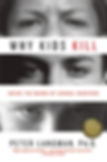Warning Signs of School Shootings in Cyberspace
In the wake of the horrific aftermath by the school shooting in Florida on Valentine's Day, we are honored to share this exclusive guest blog post from award-winning author and researcher Dr. Peter Langman, author of "Why Kids Kill: Inside the Minds of School Shooters." and "School Shooters: Understanding High School, College, and Adult Perpetrators." He provides an exclusive look at possible school shooter warning signs in Cyberspace. (originally published March 3 2018)

The Parkland Rampage Attack
In the wake of the horrific school shooting in Parkland, Florida on Valentine’s Day, people across the nation are searching for ways to prevent another massacre. With the Parkland shooting, as with so many others, there were many warning signs that were missed, including warnings online. The perpetrator in Parkland posted, “I’m going to be a professional school shooter.” He also sent messages on Snapchat regarding his desire to buy a gun, and other concerning messages.
Unfortunately, though multiple people were concerned by his posts, there was no investigation and the perpetrator killed seventeen people and wounded many others.
Online Warning Signs
The use of the Internet or social media to communicate violent intentions is nothing new. Twenty years ago, Eric Harris, one of the Columbine killers, posted his fantasies and plans for violence over a year before his attack. In some cases, school shooters have been explicit in their communications, whereas in other cases there have been hints and reasons for concern, but no direct threats. Let’s take a look at a range of warning signs that have been found in cyberspace.

Direct Threats
In 1998, Eric Harris wrote about his fantasies of mass violence, including blowing up downtown Denver and crashing a plane into New York City. More realistically, he announced online that he was going to get guns and kill people. Even more explicitly, Harris wrote about his plans to attack his high school:

(Note: “V” is a reference to Dylan Klebold, whose nickname was Vodka. “Crickets” were small explosives Harris and Klebold made.)
Online threats do not only occur in the United States. In Germany, in 2006, an 18-year-old named Sebastian Bosse posted a long message online. Here is an excerpt (GSS is the abbreviation for his school):
I thought about the fact that most students who humiliated me have already left GSS. I have two things to say to that: 1. I wasn’t just in one class, no, I went to the entire school. The people who are at the school are by no means innocent! Nobody is! The same program that also ran in previous years runs in their heads! I am the virus that wants to destroy these programs, it is completely irrelevant where I start. 2. A majority of my revenge will be aimed at the teaching staff, because those are people who interfered in my life against my will, and who helped to put me where I am standing now; On the battle field! Almost all these teachers are still at this damn school!
Similarly, in Finland, in 2007, Pekka-Eric Auvinen posted exact details about his plan:
ATTACK INFORMATION
Event: Jokela High School Massacre. Targets: Jokelan Lukio (High School Of Jokela), students and faculty, society, humanity, human race. Date: 11/7/2007. Attack Type: Mass murder, political terrorism (altough I choosed the school as target, my motives for the attack are political and much much deeper and therefore I don’t want this to be called only as “school shooting”). Location: Jokela, Tuusula, Finland. Perpetrator’s name: Pekka-Eric Auvinen (aka NaturalSelector89, Natural Selector, Sturmgeist89 and Sturmgeist). I also use pseydonym Eric von Auffoin internationally. Weapons: Semi-automatic .22 Sig Sauer Mosquito pistol.
When someone posts this level of details, the attack should be assumed to be imminent. Auvinen posted his attack plans on the morning of his rampage, leaving virtually no time for anyone to see the post and respond.
Long before he posted the details about his attack, however, Auvinen had been active online in other ways. He expressed his admiration for the Columbine killers and Hitler, posting numerous videos about them. He reportedly wrote about his desire to go on a rampage in the Finnish parliament. He also wrote, “A minority can never have any other effective means to influence the course of matters but through the use of violence,” and “I wish that death to mankind comes soon.”
By itself, this earlier material did not contain an overt threat. Taken together, however, it was enough to raise red flags for potential violence. The combination of advocating for violence, admiring Hitler and the Columbine killers, and his contemplating an attack on the government is a volatile blend of warning signs. Apparently, no one reported the warning signs, and Auvinen shot twenty people.
Elliot Rodger, who committed a multi-faceted rampage attack in 2014 at the University of California, Santa Barbara, posted multiple videos online. His final video made clear his intentions. Though the video has been removed from YouTube, here is a transcript of part of it:
On the day of retribution I’m going to enter the hottest sorority house of UCSB. And I will slaughter every spoiled, stuck-up, blond slut I see inside there. All those girls I’ve desired so much, they would have all rejected me and looked down upon me as an inferior man if I ever made a sexual advance towards them while they throw themselves at these obnoxious brutes. I’ll take great pleasure in slaughtering all of you.
No one reported Rodger’s threat, however, and he killed six people and wounded fourteen others.
Indirect Threats
As noted above in regards to Pekka-Eric Auvinen, even in the absence of direct threats, there can be warning signs online that warrant an investigation.
Kimveer Gill, a 25-year-old in Montreal who committed a rampage attack at Dawson College, had a variety of warning signs online. First, he admired Harris and Klebold, the Columbine killers, but did not say so explicitly:

In this list of his “likes,” he included Reb and V. Reb was the nickname for Eric Harris, and V was short
for Vodka, which was Dylan Klebold’s nickname (short for Vodka, which was his favor-ite drink). Calling two mass murders “Modern Day Saints” is not a direct indication of impending violence, but it is a concern.
In response to a question about how he wanted to die, he wrote: “Like Romeo and Juliet, or in a hail of bullets.” He also wrote the following for his own epitaph.

Gill also copied Eric Harris, using the phrase “ich bin Gott”, which is German for “I am God.” Harris wrote this multiple times, and Gill posted this online. He also expressed admiration for the Nazis, though he referred to them as Aryans, and wrote repeatedly “Heil Heil Heil
Gill also seemed to revel in sadistic fantasies:

In addition, he had paranoid delusions that he was being monitored by the police, as well as grandiose delusions that he was more than human:

Again, though there was no overt threat to commit violence, the idolizing of Harris and Klebold, the admiration of Hitler, the epitaph and the comments about his own death, the sadistic delight in killing and mutilation, and the delusional thinking all contribute to a potent mix. When we add to this mix the fact that he also posted fifty-one photos of himself posing with a gun, the risk increases. Unfortunately, no one reported these warning signs and he shot twenty people.
Summary
There are many ways to increase safety in our schools and communities. Based on the cases presented here, it is clear that vigilance to threats and warning signs online or on social media can play a critical role in identifying potential perpetrators and intervening before they become violent.

About the Author:
Peter Langman, Ph.D. is a psychologist who conducts trainings on preventing school shootings. He is the author of School Shooters: Understanding High School, College, and Adult Perpetrators, and Why Kids Kill: Inside the Minds of School Shooters. He maintains the world’s largest online collection of documents related to school shootings at www.schoolshooters.info.
His work has been cited in congressional testimony on Capitol Hill and he has been interviewed by the New York Times, The Today Show, 20/20, Nightline, Fox, CNN, the BBC, and over 350 other news outlets in the USA, Canada, Europe, Asia, Australia, and the Middle East. After the Sandy Hook attack, the CEO of the American Psychological Association presented Dr. Langman’s recommendations on school safety to President Obama. He has presented at the FBI National Academy in Quantico, been hired by Homeland Security to train professionals in the United States, and recruited by the State Department to speak to international audiences.





















